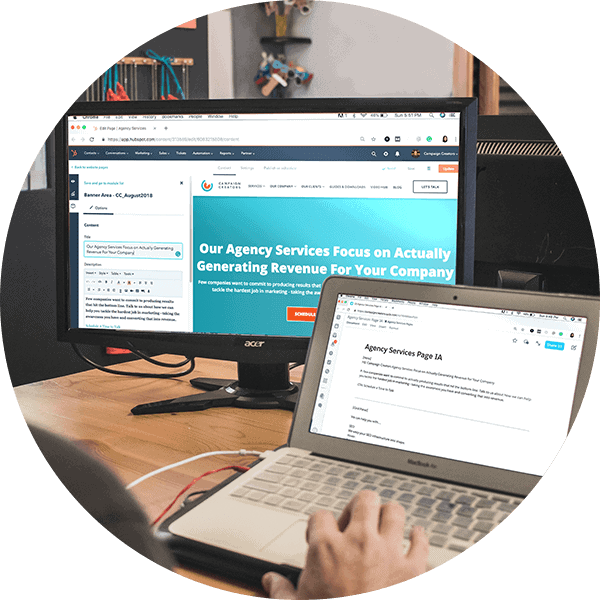
What is Structured Data, and Why Should I Care About It?
November 6, 2018
Understanding Semantic Search and How It Affects Search Engine Marketing
November 12, 2018Summary
- It All Starts with Setting Goals: A clear direction of what you’re after is necessary to make the most of your marketing reports (and efforts).
- Worthless vs. Meaningful Marketing Reports: Learn the difference between result-driven, goal-oriented, and unproductive marketing reports.
- Vanity Metrics vs. Actionable Metrics: Learn the difference between the two and get tools to assess which metrics qualify as vanity or actionable
- 5 Steps to Building Marketing Reports: From the initial goal setting to the final marketing data analysis, explore the 5-step process for building powerful marketing reports.
- Embrace Data Literacy: Cultivate a data-driven culture by empowering team members to interpret and leverage data effectively.
The Importance of Meaningful Marketing Reports

Marketing reports are essential for any marketing professional or business owner. Yet, month after month, there’s a temptation to produce reports that don’t truly reflect the effectiveness of marketing efforts. This temptation is two-fold:
- Inflating Positive Results: While a “400% increase” looks impressive, reporting should focus on what is AND isn’t working. Meaningful marketing reports should help leadership make intelligent decisions and allocate budgets wisely. If reports are full of fluff, the decisions based on them will be weak.
- Skipping Deep Metrics: It’s easy to report pre-packaged metrics like organic traffic, but meaningful metrics that show the effectiveness of your activities require effort and thoughtfulness.
Aligning sales and marketing efforts is crucial in creating meaningful marketing reports. When these teams work together towards common goals, they provide a comprehensive view of how marketing activities impact revenue. This alignment ensures that the metrics reported are relevant and actionable.
>> Learn more about our Sales & Marketing Alignment Workshop
Worthless vs. Meaningful Marketing Reports: What’s the Difference?
Every business has different objectives, but almost all center around generating revenue. A meaningful marketing report shows how your marketing contributes to these goals, while a worthless report prioritizes the marketer’s reputation over the company’s revenue goals. If your report showcases all positive results but fails to inform about revenue and conversion metrics, it’s not useful.
A Word on Vanity Metrics
The term “vanity metrics” has been referenced several times in this article, and you will encounter it further as you continue reading. Let’s take a minute to explain what vanity metrics are.
Vanity metrics refer to metrics that appear impressive on the surface but lack meaningful significance or practical value. These are measured metrics, but they do not signify a real return on investment or areas for optimization. Common examples include the number of followers, likes, or comments on social media posts.
However — and here is the confusing part — there are no universal rules about which specific metrics qualify as vanity. The distinction between vanity and non-vanity (actionable) metrics depends on the company’s objectives. Essentially, a metric is categorized as either vanity or non-vanity based on its ability to inform actionable decisions aligned with the company’s goals. For example, if you run a lead generation campaign, measuring pageviews on a landing page may not guide decisions, but tracking download rates could inspire optimization of different on-page elements.
From our experience, companies without professional marketing teams tend to get blinded by vanity metrics for several reasons. First, vanity metrics look good on paper and make the company appear better, so it’s easy to get swayed by them. Secondly, companies opt for more straightforward or positive metrics due to a lack of understanding of metric significance. But as you can probably guess, this approach is misleading and ineffective. Vanity metrics might indicate improvement on the surface, but they do not necessarily reflect the company’s success in achieving goals, and more importantly, they lack actionable value for decision-making.
But…
Before you say goodbye forever to those deceptive vanity metrics, remember that they can be helpful in the right situations. Sometimes, vanity metrics can help you take the upper hand in a public relations battle. They can help you put pressure on your competition without exposing real data about your business. And sometimes, they earn their spot on your marketing report, but it should always be for a reason.
So, How to Write a Meaningful Marketing Report?
1. Clarify Your Marketing Objectives
The first step in crafting a meaningful marketing report is clarifying your marketing objectives. These objectives should be SMART (Specific, Measurable, Achievable, Relevant, and Time-bound) and in line with the business’s broader vision and goals. Setting SMART goals is an unavoidable step that will determine where and how to focus your efforts and how to measure performance strategically.
With clearly defined objectives, aligning your marketing activities and evaluating their effectiveness becomes easier. Clarifying your SMART marketing objectives from the outset ensures that your report will provide meaningful insights and actionable data tied directly to your desired outcomes.
2. Identify and Eliminate Vanity Metrics
Once you have clear and well-defined marketing objectives, you can prioritize your metrics and key performance indicators (KPIs). As a first step, identify the vanity metrics that fail to provide genuine insights into the effectiveness of your marketing efforts.
Remember: vanity metrics can create a false sense of success, diverting attention from the true drivers of growth and revenue. Moreover, a “data explosion” (i.e., an excess of impractical data) will create more confusion than clarity, ultimately leading to futile resource allocation and missed opportunities.
3. Design Actionable Metrics Around Your Goals
Actionable metrics are the opposite of vanity metrics, providing valuable insights into how specific marketing activities directly influence your revenue and overall business objectives. By designing metrics that align with your SMART goals, you can effectively measure the impact of your marketing efforts and make data-driven decisions to optimize your strategies.
For example:
- Lead Conversion Rate: How many website visitors convert into leads? This measures the effectiveness of your content and calls to action.
- Customer Acquisition Cost (CAC): What is the total cost of acquiring a new customer? This includes marketing and sales expenses.
- Return on Marketing Investment (ROMI): Measure the revenue generated from marketing efforts against the cost of those efforts.
- Click-Through Rate (CTR): This measure indicates ad effectiveness by measuring the percentage of clicks a paid ad receives from its total views; a higher CTR suggests a relevant and compelling ad.
- Average Session Duration: Helps gauge content relevance and user engagement.
- Traffic Source: Shows the effectiveness of different marketing channels to help optimize/double down on marketing activities on the various channels.
These metrics offer valuable context and enable informed decisions. Unlike vanity metrics, actionable metrics empower you to take concrete steps to improve performance and achieve tangible results.
4. Incorporate Tools for Increased Clarity and Convenience
You likely have all the data you need if you utilize analytics and marketing automation software such as your CRM, Google Ads, Google Analytics, Google Search Console, Heat Maps, or SEMRush. However, diverse data sources are among the most common marketing analysis challenges, and, no less important, they might create data silos and gaps in data analysis.
To address this challenge, it is recommended that you consolidate your data from multiple sources into a unified dashboard that integrates seamlessly with different data analytics platforms (at Waypost Marketing, we use Looker Studio). A single, customized dashboard provides a coherent and clear view of your marketing performance, facilitating more digestible data analysis and eliminating potential inconsistencies.
5. Add Insight to the Numbers
While numbers and metrics provide valuable data points, they do not paint a complete picture of your marketing performance. To truly understand the impact of your efforts and make informed decisions, it is crucial to add insights that explain the data and provide context. By answering the following questions, you can uncover the underlying factors contributing to your results and develop strategies for future improvement:
- What were the main factors contributing to these results?
- Can you replicate the process?
- What can be done to increase the impact?
These answers, alongside the quantitative data, will allow you to transform your marketing report into a powerful tool for decision-making. These insights help you understand the reasons behind the numbers, identify patterns and trends, and develop data-driven strategies to improve future performance. Incorporating a “human touch” into your data-driven marketing efforts can help reduce the challenges of relying solely on data.
Data Literacy: Understanding and Leveraging Your Data
Once you complete all the five steps outlined above, you will be empowered with meaningful marketing reports that will work for you. But to get them to work for you, you need to be able to read them correctly, and this is where data literacy comes in.
Data literacy is crucial in today’s B2B landscape. Knowing what your data means and how to act on it can set you apart from the competition. Unfortunately, many businesses struggle with data literacy and often don’t know where to start. Here are some key points to consider:
- Understand the Basics: Learn the fundamental concepts of data analysis, including metrics, KPIs, and data sources.
- Invest in Training: Provide training for your team to ensure everyone understands how to read and interpret data.
- Use the Right Tools: Leverage tools like your CRM, Google Analytics, Google Search Console, and SEMRush to collect and analyze data effectively.
- Consult Experts: Work with professionals who can help you make sense of your data and develop strategies based on insights.
For a deeper understanding of data literacy and making data-driven decisions, download our eBook, “The Data-Driven Advantage.” This comprehensive guide explores the importance of data literacy and provides actionable strategies for leveraging your data to drive business growth.
To Conclude, Ask Yourself These Questions to Identify Vanity Metrics
To summarize, meaningful marketing reports will accomplish the following goals:
- Highlight successes and failures in meeting your company’s growth goals.
- Show how specific marketing activities contributed to those results.
- Offer insights and actionable next steps to either repeat or improve those results.
If you can’t decide on whether you should include a metric or not, ask yourself:
- Would it make sense to use the result in an important business decision?
- Do you understand exactly how you accomplished the result?
- Could you replicate or improve the result next time (Do you have control over the result)?
If the answer is no, you’ve identified a vanity metric.
By following these guidelines, businesses can ensure that their marketing reports are informative and play a crucial role in driving success. A good marketer will reject the temptation to put his reputation above his company’s goals, and a great marketer will always dig deeper to find the best answer instead of the first answer.
The Waypost Advantage
At Waypost Marketing, we value the significance of data and transparency. Our approach ensures that your marketing reports are more than just numbers on a page; they are tools to drive strategic decisions and growth. We specialize in helping businesses create meaningful reports highlighting successes and providing actionable insights.
Are you ready to revamp your marketing reporting and achieve real growth? Contact Waypost Marketing today to discover how we can help you develop meaningful reports that steer your strategic decisions and enhance your bottom line.









